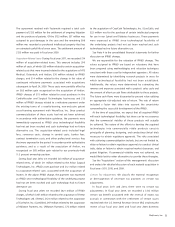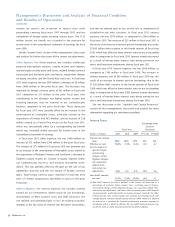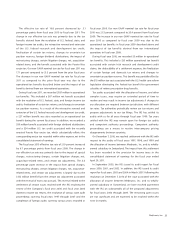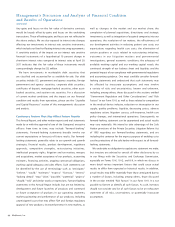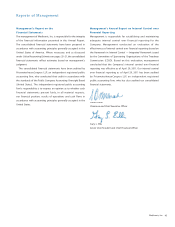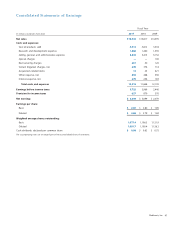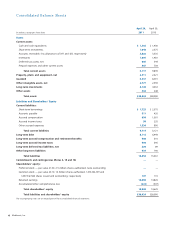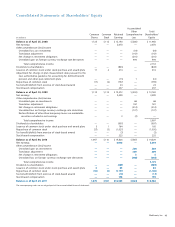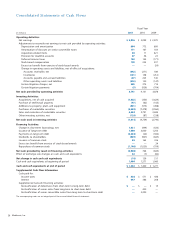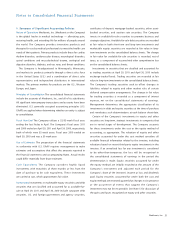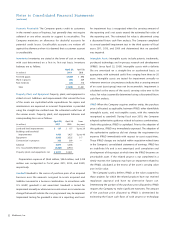Medtronic 2011 Annual Report Download - page 47
Download and view the complete annual report
Please find page 47 of the 2011 Medtronic annual report below. You can navigate through the pages in the report by either clicking on the pages listed below, or by using the keyword search tool below to find specific information within the annual report.
43
Medtronic, Inc.
Operations Outside of the United States
The table below illustrates U.S. net sales versus net sales outside
the U.S. for fiscal years 2011, 2010, and 2009:
Fiscal Years
(in millions) 2011 2010 2009
U.S. net sales $ 9,120 $ 9,366 $ 8,987
Non-U.S. net sales 6,813 6,451 5,612
Total net sales $ 15,933 $ 15,817 $ 14,599
From fiscal year 2010 to fiscal year 2011, net sales in the U.S.
decreased 3 percent and net sales outside the U.S. increased 6
percent. Foreign currency had a favorable impact of $12 million
on net sales for fiscal year 2011. The prior year also had
approximately $200 million of revenue benefit from the extra
week in the first quarter of fiscal year 2010. Outside the U.S.,
net sales growth was led by strong double-digit growth in
CardioVascular, Diabetes, and Surgical Technologies. CardioVascular
net sales were led by increased sales of Resolute and Resolute
Integrity, contributions from the acquisitions of Invatec and ATS
Medical, CoreValve transcatheter valves, and Endovascular.
Diabetes net sales increased as a result of strong Veo pump sales.
Increased sales of the O-Arm Imaging System led to the Surgical
Technologies growth. Additionally, outside the U.S. net sales in
Japan were negatively impacted by approximately $15 million
in the fourth quarter of fiscal year 2011 due to the earthquake
and tsunami.
From fiscal year 2009 to fiscal year 2010, consolidated net
sales in the U.S. and outside the U.S. grew 4 percent and 15
percent, respectively. Foreign currency had a positive impact of
$113 million on net sales for fiscal year 2010. Outside the U.S.,
net sales growth was strong across all of our businesses and was
led by strong performance in CardioVascular, Neuromodulation,
Diabetes, Spinal, and Surgical Technologies. CardioVascular net
sales were led by increased sales of Resolute, Endeavor, CoreValve
transcatheter valves, and Endovascular. Pain Stimulation products,
DBS and Urology and Gastroenterology led the increase within
our Neuromodulation business. Diabetes sales increased as a
result of strong pump sales driven by the expanded launch of
Veo. Spinal net sales growth was led by growth in BKP and from
our joint venture with Weigao. Increased sales of the O-Arm
Imaging System led to the growth within the Surgical Technologies
business outside the U.S.
Net sales outside the U.S. are accompanied by certain financial
risks, such as collection of receivables, which typically have
longer payment terms. We monitor the creditworthiness of our
customers to which we grant credit terms in the normal course
of business. However, a significant amount of our outstanding
accounts receivables are with national health care systems in
many countries. In light of the economic state of many foreign
countries, we continue to monitor their creditworthiness. During
fiscal year 2011, we established additional bad debt reserves in
certain markets, including Greece. Although we do not foresee a
significant credit risk associated with these receivables, repayment
is dependent upon the financial stability of the economies of
those countries. Outstanding receivables from customers outside
the U.S. totaled $2.345 billion at April 29, 2011 or 60 percent, of
total outstanding accounts receivable, and $1.855 billion at April
30, 2010, or 55 percent of total outstanding accounts receivable.
Market Risk
Due to the global nature of our operations, we are exposed to
currency exchange rate changes. In a period where the U.S. dollar
is strengthening/weakening as compared to other currencies,
our foreign currency revenues, net of foreign currency expenses,
are translated into U.S. dollars at a lower/higher value than
they would be in an otherwise constant currency exchange rate
environment.
We use operational and economic hedges, as well as currency
exchange rate derivative instruments to manage the impact of
currency exchange rate changes on earnings and cash flows.
In order to minimize earnings and cash flow volatility resulting
from currency exchange rate changes, we enter into derivative
instruments, principally forward currency exchange rate contracts.
These contracts are designed to hedge anticipated foreign
currency transactions and changes in the value of specific
assets, liabilities, and probable commitments. At inception of the
contract, the derivative is designated as either a freestanding
derivative or a cash flow hedge. The primary currencies of the
derivative instruments are the Euro and Japanese Yen. We do
not enter currency exchange rate derivative instruments for
speculative purposes.
We had foreign exchange rate derivative contracts outstanding
in notional amounts of $6.834 billion and $5.495 billion at April
29, 2011, and April 30, 2010, respectively. At April 29, 2011, these
contracts were in an unrealized loss position of $283 million. A
sensitivity analysis of changes in the fair value of all foreign
exchange rate derivative contracts at April 29, 2011 indicates that
if the U.S. dollar uniformly strengthened/weakened by 10 percent
against all currencies, the fair value of these contracts would
increase/decrease by approximately $579 million, respectively.


